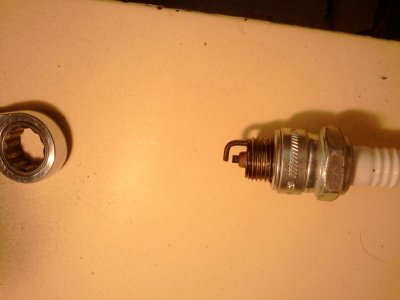Ok now that you have confirmed the vacuum lines are all good (no leaks) The nect thing to check is the power valve in the carburetor; that is unless you have removed it and plugged the hole. On a holley behind the front float bowl in the plate that holds the jets at the bottom is a part called the power valve. This power valve is critical in helping to control the engine at idle. What it does is when the idle trys to drop off it will allow more fuel to enter the idle circuit which keeps the engine from dying. The power valve is sentisitive to back fires through the carburetor. Most powere valves will blow after it has experienced 2 to 3 carburetor back fires. They can stand only so many beofre the little diaphrams give out, then they stop working. Again the power valve is also dependent on good engine vacuum. Also each power valve is set for a spicific engine vacuum and the size of your power valve is probably stamped in really small digits on the side of the valve.
What determings the size is the amount of vacuum your engine pulls and the size of your am shaft can really make a huge difference in the size you need. Cam shafts with a lot of over lap can cause low engine vacuum so you will need a power valve that opens at a low vacuum signal.
It has been a long time since I worked on a holly carb but I bet if you go to the Holly web site they will have plenty of information on how to check the power valve and the different sizes they sell.
But, you are in some what of a delima unless you know what your vacuum was before you had this problem.
If you have an after market camshaft you should have already checked your inches of vacuum and logged it into your records.
If you are running a factory can shaft you can probably safely say that your engine is pulling at least 16 to 18 inches of vacuum in a well used condition. If the engine is new with fresh rings and valve job it could be higher up to 20 to 21 inches. I forget the spread of how many inches of vacuum each power valve covers but again check with holley for the appropriate info and make a judgment call based on what you know about your engine.
PS There is one other thing to check.
You need to check your choke plate. Some of the holley choke plates need to run at about a 1/8 inch opening to the air horn untill the engine starts to warm up. Then as the engine warms the choke plate will gradually start to open at a rate equal to the engine temperature. With all that said, if your linkages to your choke plate are gummed up, bent, out of adjustment to where the plate opening is too wide then the engine will not idle properly when it is stone cold.
Keep in mind, a cold emgine needs a lot of raw fuel in order to keep running on initial startup. Anything preventing this needed additional fuel is going to keep the engine from idling properly.
So before pulling the carbureor apart to check the power valve take a look at your choke assembly. Get your self a shop manual and get the settings for the plate opening, and the rate of choke pull off.
The choke pull off, The choke pull off is a little vacuum canister generally bolted or rivited to one corner of the carburetor. it has a linkage that attaches to the choke linkages and a vacuum line that runs between it and the carburetor.
If the choke pull off is not working at all then you choke plate may be staying closed at start up which is flooding the engine and causing it to immediately die.
If the choke pull off is out of adjustment and opening the plate too far then the engine is running too lean at start up and again it will die or run poorly.
Please note; if you noticed every thing I just told you relies on engine vacuum. I know you said everything is good with the vacuum lines but trust me with out proper vacuum nothing works correctly in your tune up.
If you have low vacuum
The power valve fails
The choke pull off fails
The choke plate fails.
The distribuitor vacuum advance fails
If all five of these things are going to be effected due to low vacuum, and they will, then you can see how low vacuum could cause a problems.
About 13 miles East of Ft Leonarwood just off I-44
Or 125 miles west of St Louis

















